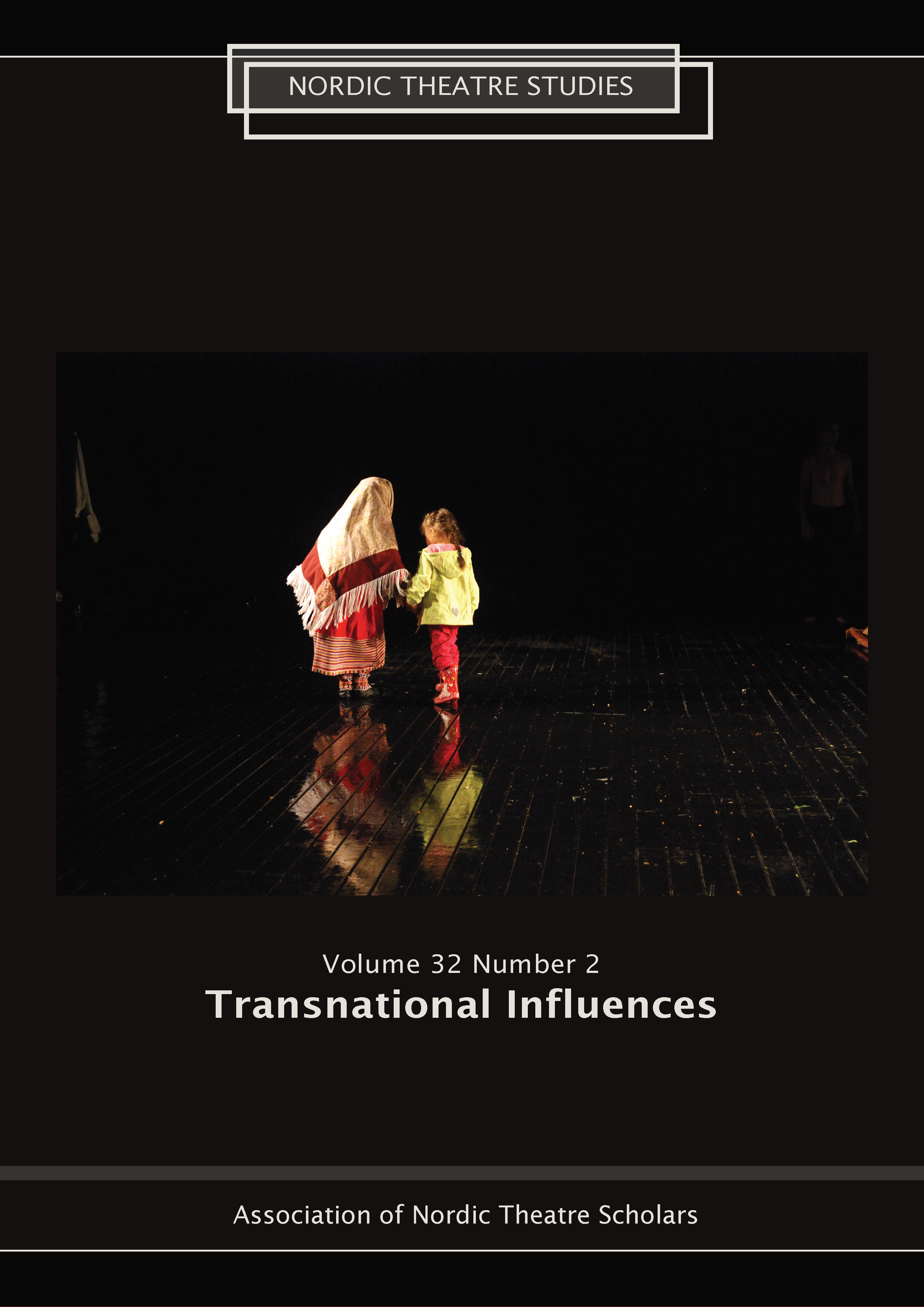The Travelling of Dramatic Texts and Memory Patterns
The Case of Estonian Memory Theatre
DOI:
https://doi.org/10.7146/nts.v32i2.124347Keywords:
Transnational/transcultural/travelling memory, memory narratives and practices, memory forms/patterns, Estonian memory theatre, Rein Saluri, Merle KarusooAbstract
The article discusses Estonian memory theatre in the 1970s–90s and at the beginning of the twenty-first century in the framework of transnational/transcultural influences. Dwelling on Jeanette R. Malkin’s definition of memory theatre as a theatre that both imitates the flow of memories and initiates the process of remembrance, and relying on the concepts of transnational and transcultural memory, I analyze the dramatic texts of Estonian playwrights Rein Saluri and Madis Kõiv, likewise the works of female stage director Merle Karusoo. I focus on the phenomenon of travelling memory, introduced by scholar of literature and culture, Astrid Erll, and engage a comparative approach to the texts and stage interpretations. Through the media of texts and mnemonic forms in motion and on the basis of particular case studies, I examine how stories/narratives, memory patterns, and mnemonic practices have crossed cultural borderlines and been performed on different (Estonian, Finnish, Estonian-Russian, Austrian) stages, and how they have primarily launched hidden or blurred memories.
References
Agranovskaja, Ella. 2006. ““Сегодня не играем.” Почему?” Молодёжь Эстонии. Суббота 3.6.2006.
Allik, Jaak. 2006. “Nad tõesti ei mängi, vaid ongi sellised!” Postimees 1.6.2006.
Carlson, Marvin. 2001. The Haunted Stage. The Theatre as Memory Machine. Ann Arbor: The University of Michigan Press.
Epner, Luule. 2007. “Rupture and Continuity: How History and Memory Are Represented on the Stage.” In Anneli Mihkelev, Benedikts Kalnačs (eds.). We Have Something in Common. The Baltic Memory. Collegium litterarum 21. Tallinn: The Under and Tuglas Literature Centre of the Estonian Academy of Sciences, Institute of Literature, Folklore and Arts of the University of Latvia, 177–196.
Epner, Luule. 2010. “Telling Life Stories as a Strategy of Authentication? Merle Karusoo’s Our Biographies and Today We Won’t Play.” In Mateusz Borowski, Małgorzata Sugiera (eds.). Worlds in Words: Storytelling in Contemporary Theatre and Playwriting. Cambridge: Cambridge Scholars Publishing, 107−126.
Erll, Astrid. 2011. “Travelling Memory.” Parallax 17:4, 4–18.
Etelapää, Heikki. 1988. “Pakkosiirron painajainen.” Uusi Suomi 9.10.1988.
Gluhovic, Milija. 2013. Performing European Memories. Trauma, Ethics, Politics. Basingstoke, New York: Palgrave Macmillan.
Hirsch, Marianne. 2012. The Generation of Postmemory: Writing and Visual Culture After the Holocaust. New York: Columbia University Press.
Jandl, Paul. 2004. “Am Ende des Tobens Seht die Farce.” Neue Zürcher Zeitung 10.6.2004.
Karro, Tõnu. 1988. “Täiendusi Juudase loole. “Minek” Pärnu Draamateatris.” Rahva Hääl 15.5.1988.
Karusoo, Merle. 2000. “Põhisuunda mittekuuluv.” Teater. Muusika. Kino 2/2000, 15–27.
Karusoo, Merle; Saro, Anneli; Lepsoo, Tanel. 2014. Intervjuu Merle Karusooga. Methis. Representatsioon draamas ja teatris 14, 136–143.
Kolk, Madis. 2006. “Mittemängu manifest.” Teater. Muusika. Kino 7/2006, 49–51.
Kruuspere, Piret. 2002. “Merle Karusoo’s memory theatre.” Interlitteraria 7: World Drama on the Threshold of the 21st Century: Tradition and Avant-garde II, 276–289.
Kruuspere, Piret. 2009. “Estonian Memory Theatre of the 1990s: Emotional Scale from Fear to Laughter.” Nordic Theatre Studies 21, 88–97.
Kruuspere, Piret. 2017. “Eesti näitekirjandus ja teater kultuurimälu meediumidena.” Philologia Estonica Tallinnensis 2, 35–58.
Laanes, Eneken. 2009. Lepitamatud dialoogid. Subjekt ja mälu nõukogudejärgses eesti romaanis. Oxymora 6. Tallinn: Underi ja Tuglase Kirjanduskeskus.
Laanes, Eneken. 2017. “Trauma keeled tõlgitud. Kultuurideülesed mäluvormid eesti laagri- ja küüditamismälestustes.” Keel ja Kirjandus 4, 241–257.
Lehtonen, Soila. 1988. “Virolaista dokumenttiteatteria kansallisessa.” Kansan Uutiset 25.10.1988.
Malkin, Jeanette R. 1999. Memory-Theater and Postmodern Drama. Ann Arbor: The University of Michigan Press.
Morning, Kirsikka. 1988. “Lähtö. Koskettava näytelmä virolaisten pakkosiirroista.” Helsingin Sanomat 9.10.1988.
Oja, Arno. 1989. “Rassistumise fenomen. Ühest probleemist Rein Saluri kahes uues raamatus.” Reede 22.10.1989.
Pavis, Patrice. 1998. Dictionary of Theatre. Terms, Concepts, And Analysis. Toronto, Buffalo: University of Toronto Press.
Pedajas, Priit. 1988. “Vastab Priit Pedajas.” Teater. Muusika. Kino 9/1988, 5–11.
Pii, Paul. 1988. “Tunnustust vääriv. Tallinna Draamateatri hooaeg 1987/1988.” Sirp ja Vasar 14.10.1988.
Repson, Ksenija. 2006. “Играем сегодня, завтра и всегда.” Postimees (in Russian), 1.6.2006.
Rigney, Ann. 2016. “Transnational Memory.” Encyclopédie critique du témoignage et de la mémoire. http://memories-testimony.com/notice/transnational-memory/ (27.2.2020).
Saluri, Rein. 1988. Lähtö. Translated by Eva Lille. Unpublished manuscript in the library of Nordic Drama Corner.
Saluri, Rein. 1989. Sõiduraamat. Minek. Poiste sõidud. Külalised. Tallinn: Eesti Raamat.
Saluri, Rein. 1990. Depature. A play in two acts. Translated by Krista Kaer. Unpublished manuscript in the library of Estonian Theatre Agency.
Saluri, Rein. 1999. Katked 1958–1999. Tallinn: Perioodika.
Tonts, Ülo. 1988. “Kaks viimast tundi kahel laval. R. Saluri “Minek” Pärnu ja Šiauliai teatris.” Sirp ja Vasar 20.5.1988.
Valgemäe, Mardi. 1990. “Saluri pool-“Minek”.” Aja Kiri 58/1990, 8–9.
Vellerand, Lilian. 1989. “Olovernese pea. Mõeldes möödunud teatrihooajale.” Teater. Muusika. Kino 9/1989, 68–76.
Visnap, Margot. 1989. “Minekule määratud rahva selginevad kontuurid. Neli eesti teatri lavastust.” Teater. Muusika. Kino 1/1989, 26–37.
Visnap, Margot. 2004. “Merle Karusoo andis austerlastele tagasi tükikese ajalugu.” Sirp 2.7.2004.
Visnap, Margot. 2006. “Sa oled mind ju sünnitand ja üles kasvatand ...” Sirp 9.6.2006.
Downloads
Published
How to Cite
Issue
Section
License
The copyright belongs to the authors and Nordic Theatre Studies. Users can use, reuse and build upon the material published in the journal but only for non-commercial purposes. Users are allowed to link to the files, download the files, distribute the files on a local network (preferably by links), upload the files to local repositories if their institutions require them to do so, but not republish the files without proper agreements with the journal and the author.

